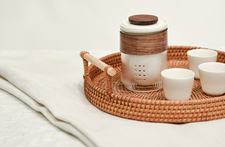Customize your system tray with YAD
Bespoke System Tray

© Photo by Suhyeon Choi on Unsplash
YAD lets you customize your system tray with one-line Bash tray scripts.
My goal was to find a simple way to group together my favorite apps and web pages into a system tray item. There are a number of different approaches to this, but for my requirements I found that the YAD (Yet Another Dialog) tool [1] gave me everything that I needed, and I could do it all with just one line of Bash script.
In this article, I will introduce Bash tray scripts with three examples. The first example will show how to create tray scripts that put Linux diagnostic data into both custom dialogs and terminal windows. In the second example, I will add pop-up browser windows to a right-click submenu. The final example will look at how to toggle the tray icon, command, and tooltip with simulated weather conditions.
Getting Started
There are a number of different tools for creating system tray applications, such as AllTray and KDocker. For my projects, I prefer YAD because it lets you create custom dialogs and it supports dynamic changes to the tray features. YAD is a command-line dialog tool very similar to Zenity [2], but with some added features such as system tray support and a more complete dialog functionality.
[...]
Buy this article as PDF
(incl. VAT)
Buy Linux Magazine
Subscribe to our Linux Newsletters
Find Linux and Open Source Jobs
Subscribe to our ADMIN Newsletters
Support Our Work
Linux Magazine content is made possible with support from readers like you. Please consider contributing when you’ve found an article to be beneficial.

News
-
Zorin OS 18 Hits over a Million Downloads
If you doubt Linux isn't gaining popularity, you only have to look at Zorin OS's download numbers.
-
TUXEDO Computers Scraps Snapdragon X1E-Based Laptop
Due to issues with a Snapdragon CPU, TUXEDO Computers has cancelled its plans to release a laptop based on this elite hardware.
-
Debian Unleashes Debian Libre Live
Debian Libre Live keeps your machine free of proprietary software.
-
Valve Announces Pending Release of Steam Machine
Shout it to the heavens: Steam Machine, powered by Linux, is set to arrive in 2026.
-
Happy Birthday, ADMIN Magazine!
ADMIN is celebrating its 15th anniversary with issue #90.
-
Another Linux Malware Discovered
Russian hackers use Hyper-V to hide malware within Linux virtual machines.
-
TUXEDO Computers Announces a New InfinityBook
TUXEDO Computers is at it again with a new InfinityBook that will meet your professional and gaming needs.
-
SUSE Dives into the Agentic AI Pool
SUSE becomes the first open source company to adopt agentic AI with SUSE Enterprise Linux 16.
-
Linux Now Runs Most Windows Games
The latest data shows that nearly 90 percent of Windows games can be played on Linux.
-
Fedora 43 Has Finally Landed
The Fedora Linux developers have announced their latest release, Fedora 43.

